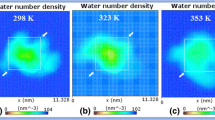Abstract
A theoretical solvation model of peptides and proteins that mimics the heterogeneous membrane-water system was proposed. Our approach is based on the combined use of atomic parameters of solvation for water and hydrocarbons, which approximates the hydrated polar groups and acyl chains of lipids, respectively. This model was tested in simulations of several peptides: a nonpolar 20-mer polyleucine, a hydrophobic peptide with terminal polar groups, and a strongly amphiphilic peptide. The conformational space of the peptides in the presence of the membrane was studied by the Monte Carlo method. Unlike a polar solvent and vacuum, the membrane-like environment was shown to stabilize the α-helical conformation: low-energy structures have a helicity index of 100% in all cases. At the same time, the energetically most favorable orientations of the peptides relative to the membrane depend on their hydrophobic properties: nonpolar polyleucine is entirely immersed in the bilayer and the hydrophobic peptide with polar groups at the termini adopts a transbilayer orientation, whereas the amphiphilic peptide lies at the interface parallel to the membrane plane. The results of the simulations agree well with the available experimental data for these systems. In the following communications of this series, we plan to describe applications of the solvation model to membrane-bound proteins and peptides with biologically important functional activities.
Similar content being viewed by others
Abbreviations
- ASP:
-
atomic solvation parameters
- MC:
-
Monte Carlo
- MD:
-
molecular dynamics
- TM:
-
transmembrane
References
Deber, C.M. and Li, S.-C.,Biopolymers, 1995, vol. 37, pp. 295–318.
Bechinger, B.,J. Membr. Biol., 1997, vol. 156, pp. 197–211.
Hunt, J.F., Earnest, T.N., Bousch, O., Kalghatgi, K., Reilly, K., Horváth, C., Rothschild, K.J., and Engelman, D.M.,Biochemistry, 1997, vol. 36, pp. 15156–15176.
Edholm, O. and Jähnig, F.,Biophys. Chem., 1988, vol. 30, pp. 279–292.
Milik, M. and Skolnick, J.,Proteins, 1993, vol. 15, pp. 10–25.
Huang, P. and Loew, G.H.,J. Biomol. Struct. Dyn., 1995, vol. 12, pp. 937–956.
Nolde, D.E., Arseniev, A.S., Vergoten, G., and Efremov, R.G.,J. Biomol. Struct. Dyn., 1997, vol. 15, pp. 1–18.
Ducarme, P., Rahman, M., and Brasseur, R.,Proteins, 1998, vol. 30, pp. 357–371.
Efremov, R.G., Nolde, D.E., Vergoten, G., and Arseniev, A.S.,Theor. Chem. Acc., 1999, vol. 101, pp. 170–174.
Efremov, R.G., Nolde, D.E., Vergoten, G., and Arseniev, A.S.,Biophys. J., 1999, vol. 76, pp. 2448–2459.
Efremov, R.G., Nolde, D.E., Vergoten, G., and Arseniev, A.S.,Biophys. J., 1999, vol. 76, pp. 2460–2471.
Popot, J.-L.,Curr. Opin. Struct. Biol., 1993, vol. 3, pp. 532–540.
Lemmon, M. and Engelman, D.M.,Q. Rev. Biophys., 1994, vol. 27, pp. 157–218.
Sansom, M.S.P.,Curr. Opin. Struct. Biol., 1998, vol. 8, pp. 237–244.
Tielman, D.P., Marrink, S.J., and Berendsen, H.J.C.,Biochim. Biophys. Acta, 1997, vol. 1331, pp. 235–270.
Jähnig, F. and Edholm, O.,Z. Phys. B: Condens. Matter, 1990, vol. 78, pp. 137–143.
Jähnig, F. and Edholm, O.,J. Mol. Biol., 1992, vol. 226, pp. 837–850.
Edholm, O., Berger, O., and Jähnig, F.,J. Mol. Biol., 1995, vol. 250, pp. 94–111.
Gazit, E., La Rocca, P., Sansom, M.S.P., and Shai, Y.,Proc. Natl. Acad. Sci. USA, 1998, vol. 95, pp. 12 289–12 294.
Némethy, G., Pottle, M.S., and Sheraga, H.A.,J. Phys. Chem., 1983, vol. 87, pp. 1883–1887.
Von Freyberg, B. and Braun, W.,J. Comput. Chem., 1991, vol. 12, pp. 1065–1076.
Metropolis, N., Rosenbluth, A.W., Teller, A.H., and Teller, E.,J. Chem. Phys., 1953, vol. 21, pp. 1087–1092.
Kabsch, W. and Sander, C.,Biopolymers, 1983, vol. 22, pp. 2577–2637.
Eisenberg, D., Weiss, R.M., and Terwilliger, T.C.,Proc. Natl. Acad. Sci. USA, 1984, vol. 81, pp. 140–144.
Donnelly, D., Overington, J.P., Ruffle, S.V., Nugent, J.H., and Blundell, T.L.,Protein Sci., 1993, vol. 2, pp. 55–70.
Koradi, R., Billeter, M., and Wüthrich, K.,J. Mol. Graphics, 1996, vol. 14, pp. 51–55.
Chipot, C. and Pohorille, A.,J. Am. Chem. Soc., 1998, vol. 120, pp. 11 912–11 924.
Brasseur, R., Pillot, T., Lins, L., Vandekerckhove, J., and Rosseneu, M.,Trends Biochem. Sci., 1997, vol. 22, pp. 167–171.
Bechinger, B., Gierasch, L.M., Montal, M., Zaloff, M., and Opella, S.J.,Solid State NMR Spec., 1996, vol. 7, pp. 185–192.
Munoz, V., Thompson, P.A., Hofrichter, J., and Eaton, W.A.,Nature, 1997, vol. 390, pp. 196–199.
Author information
Authors and Affiliations
Corresponding author
Rights and permissions
About this article
Cite this article
Nolde, D.E., Volynskii, P.E., Arseniev, A.S. et al. Modeling of peptides and proteins in a membrane environment: I. A solvation model mimicking a lipid bilayer. Russ J Bioorg Chem 26, 115–124 (2000). https://doi.org/10.1007/BF02759157
Received:
Revised:
Issue Date:
DOI: https://doi.org/10.1007/BF02759157




